Hello amazing gamers!
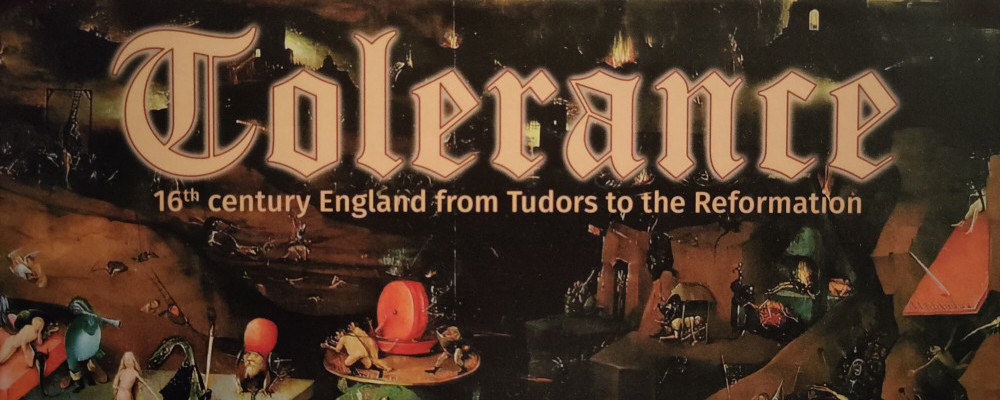
Welcome to my review and update on Tolerance, another fantastic card game from Dragon Dawn Productions!
Immerse yourself in the politics of Tudor Britain as you play in this deeply-themed trick-taking game!
Gamefound campaign starts 19th March 2023!
Read my previous review of Tolerance where I play-tested an earlier prototype of the game.
Tolerance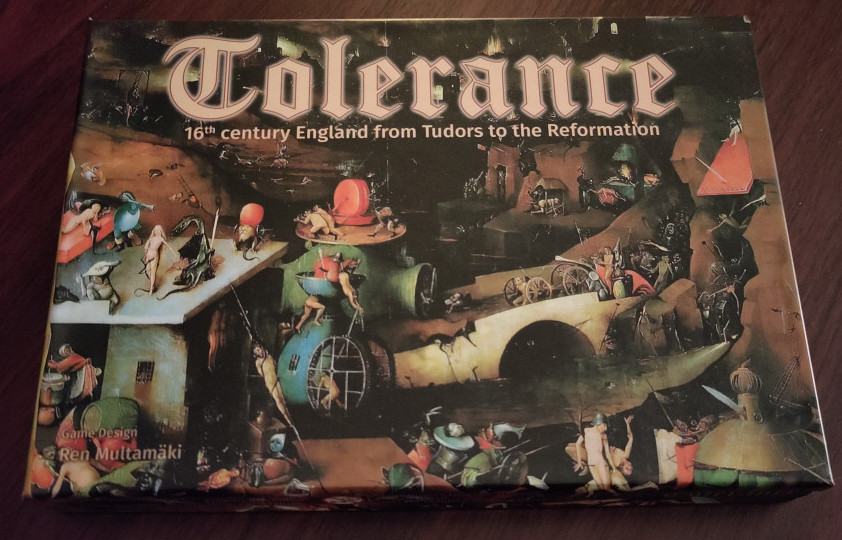
Ages: 12+
No. of players: 3-5
Designers: Ren Multamäki
Artist: Lars Munck
Publisher: Dragon Dawn Productions
Time: 45 mins
Tolerance is a great little game for 3-6 players. On the surface it is a simple trick-taking game, but it has several levels which make it way more fun and interactive than your average card game!
Check out the other Dragon Dawn games I’ve reviewed here!
Artwork
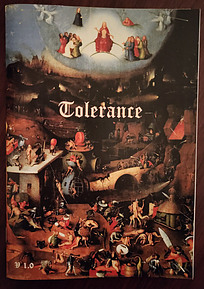
The first thing you’re likely to notice is the artwork which is all made up of period pieces from the era. I love the card art! Each of the 73 cards has its own unique character art.
This is such a great touch and really brings you into the world of 16th Century Britain. Every card has its own personality, some are historical figures from the era such as King James or Francis II, some are representative of typical careers at the time such the Village Reeve or the Bailiff and some are more fantastical such as the Alluring Witches or the Satyr.
Cards are divided into five suits, Nobles, Clergy, Townsmen, Peasants and Wild, numbered 1-14. Each card also has a religious affiliation: either Catholic, Protestant or Neutral. This adds a second dimension to the game as you will be strategically playing cards for their suits and for their religions.
Like trick-taking games? Take a look at White Hat!
Intolerance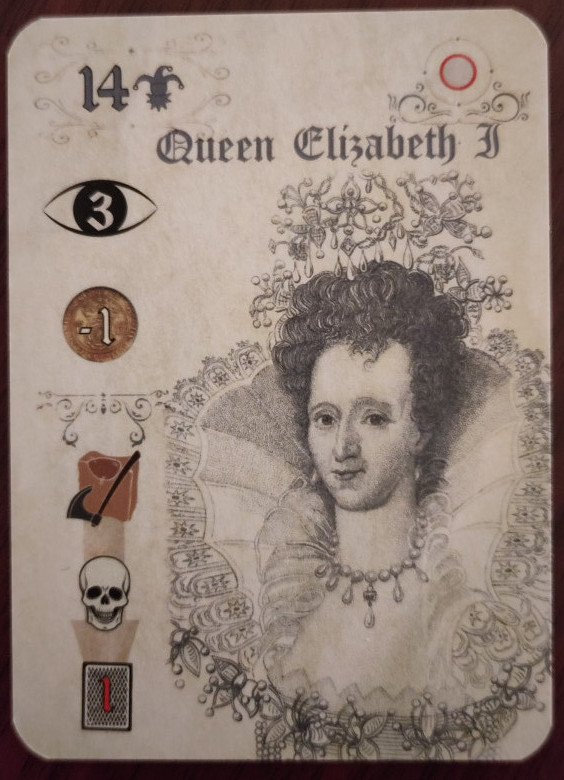
The game focuses on the shifting balance of power between the Catholics and the Protestants in Britain in the aftermath of Henry VIII’s religious reforms. There is a narrative to the game as you play three rounds of 12 hands, each round representing the reign of successive monarchs.
The first round is during the reign of Queen (Bloody) Mary I, the second is under the ‘Virgin’ Queen Elizabeth I and the final round during the reign of James I. Each monarch had a different attitude to religious freedom and the game mechanics reflect this.
Bloody Mary was a devout Catholic and executed around 300 Protestant dissenters during her reign. Mary’s half-sister Elizabeth was more tolerant while James I was ardently Protestant. To account for this, all Neutral cards are Catholic during Mary’s reign and Protestant during James’ reign. In Elizabeth’s reign, they remain Neutral.
So we already have two axes of strategy with both the suits and the religions playing a part. The third axes is the End of Round Effects.
Like games with an historical theme? Take a look at Maeshowe!
Card Anatomy
Cards will tell you which suit they are and what rank in that suit. But they have a lot more information on them which is important to the mechanics of the game.
They will also tell you which religion, if any, they are, how much Piety and Gold they have and whether they have an End of Round Effect. They also have their individual character art and name which brings a great bit of flavor to the game.
Like card games? Take a look at Dwarf!
End of Trick Effects
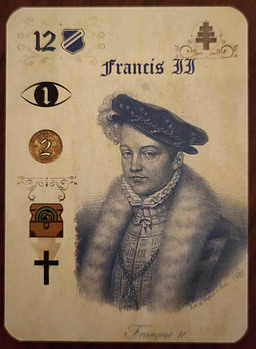
Many cards have end of trick effects. These are actually very fun to play out and, if one feels inclined, can lead to interesting narratives developing.
There are five possible end of trick effects. Collect Taxes, Collect Piety, Condemn, Convert and Kill. Each card in the hand played enacts their end of round effects in order, starting with the highest numbered card.
‘Collect Taxes’ brings in coin from the other cards played for the winner of the trick and ‘Collect Piety’ does the same for Piety. Gold and Piety will count towards your total victory points at the end, so you will be looking to accrue as much as possible.
A card which has the ‘Condemn’ end of trick effect will target the card of the relevant type with the lowest Piety score and if it can beat that score will then kill that character. If this character has not already enacted its end of trick effect, it will not be able to, now that it is dead!
‘Convert’ targets another card in the same way as Condemn but instead of killing it, it converts it from one religion to another. And Kill does what it says on the tin!
Like games with a deep theme? Take a look at Gray Eminence!
Game Play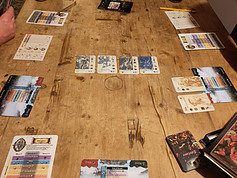
As I alluded to earlier, there are several axes of strategy occurring simultaneously during game play. The first is the standard card-game mechanic of trick taking. Suits and ranks determining the winner.
Layered on top of this familiar style of play is the Gold and Piety that each card could give, working in conjunction with the End of Trick effects. There is also the religion of the card which is independent from its suit and rank.
The religion aspect really comes into effect if you are playing the asymmetric game where each player has a different character card. Each character has different victory conditions and will have affinity or antipathy for a particular religion.
This means that Some players will be looking to gain as many cards of a particular religion as they can. Some players will get bonuses or maluses if these cards they win are ‘dead’ or ‘living’.
For example, the character Pierre is a hard-line Catholic and will gain Victory Points for all the dead Protestants he can win in a round, and will lose Victory Points for all the dead Catholics on his board at the end. By keeping an eye on the other players’ victory conditions, you can be very tactical about which cards to play in the trick in order to screw your opponents over!
Check out the awesome dice-less dungeon-crawler from Dragon Dawn, Perdition’s Mouth!
The Narrative
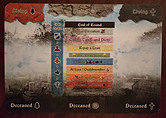 The overall game clearly has its own narrative involving the balance of power between Catholics and Protestants during the Tudor times, but the cards and game mechanics themselves tend to form their own unique narrative as you play. The fact that each card is unique and through the way that the cards interact with each other at the end of the trick allows the players to have a bit fun creating a narrative which will be unique to each game.
The overall game clearly has its own narrative involving the balance of power between Catholics and Protestants during the Tudor times, but the cards and game mechanics themselves tend to form their own unique narrative as you play. The fact that each card is unique and through the way that the cards interact with each other at the end of the trick allows the players to have a bit fun creating a narrative which will be unique to each game.
There are lovely little narrative opportunities at the end of each trick, for example, when the Valiant Knight murders a noble at the end of the trick, it is totally optional, but adds a lot of flavor to the game to narrate this.
The multi-axes game play also means that victory can be bitter-sweet as you may win the trick but end up with several dead Catholics which means you lose Victory Points if you are playing Pierre! This makes the game engaging and fun and keeps me coming back for more as I want to experiment with different character combinations.
Like narrative games? check out Warhammer Fantasy Roleplay!
Final Thoughts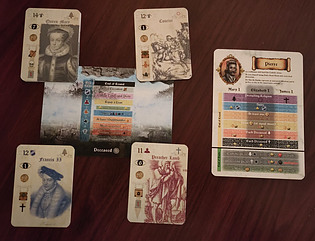
I really like Tolerance! I love the individual card art and the asymmetric game play. I played it with my kids and although they liked it and particularly enjoyed the theme, the deeper tactics were a bit lost on them. When I played with my gaming group, however, they quickly picked up the rules and began adding narration to the end of tick effects which was a good laugh!
I would say it takes a couple of plays to begin to really explore the different tactics that the multi-dimensional game play offers, but I would say that this is a good thing! Tolerance is a great game with a rich theme and deep game play, layered upon the familiarity of a traditional trick-taking game.
It is a great game for introducing to people who may be familiar with traditional card games, but not much experience of modern board games and equally it is suitable for veteran gamers. I would thoroughly recommend Tolerance!
Tolerance is going through its final play-testing before the Gamefound launches which are coming soon so watch this space!
Read my reviews of some other great Dragon Dawn Productions games here!
Visit the Dragon Dawn Productions website here!
Find out what other card games I’ve reviewed here!
And as always, thanks for reading!
– Bren